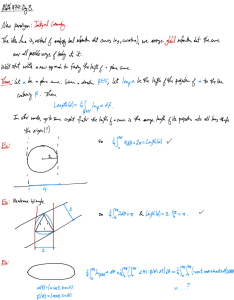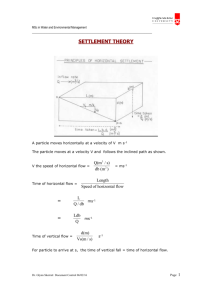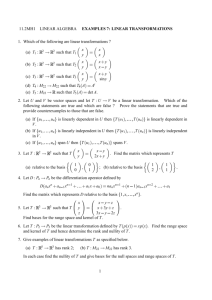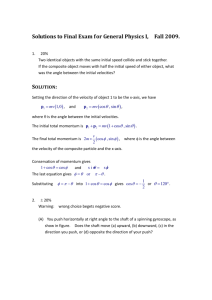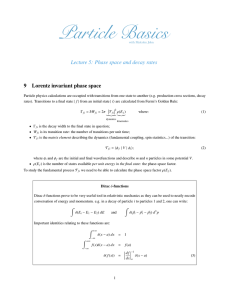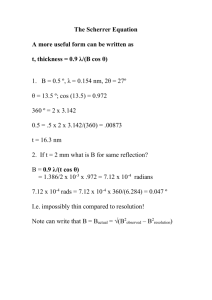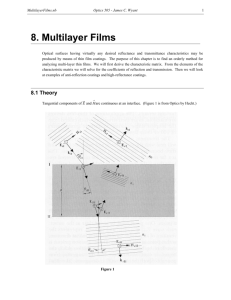Homework 3 Solution
advertisement
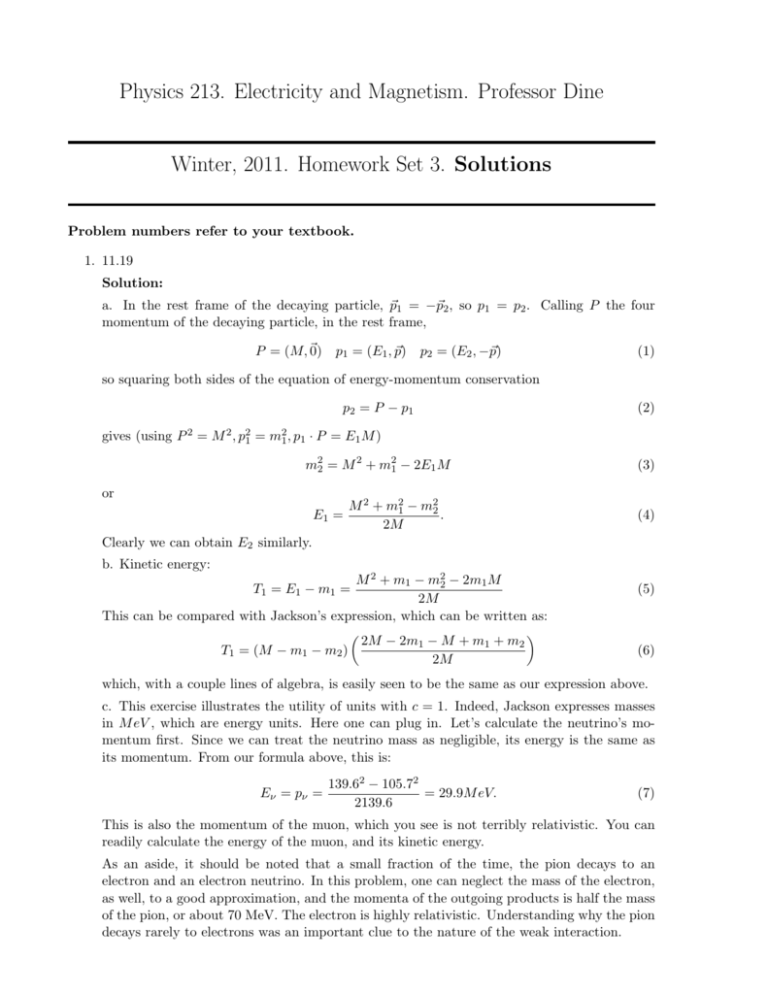
Physics 213. Electricity and Magnetism. Professor Dine Winter, 2011. Homework Set 3. Solutions Problem numbers refer to your textbook. 1. 11.19 Solution: a. In the rest frame of the decaying particle, p~1 = −~ p2 , so p1 = p2 . Calling P the four momentum of the decaying particle, in the rest frame, P = (M, ~0) p1 = (E1 , p~) p2 = (E2 , −~ p) (1) so squaring both sides of the equation of energy-momentum conservation p2 = P − p1 (2) gives (using P 2 = M 2 , p21 = m21 , p1 · P = E1 M ) m22 = M 2 + m21 − 2E1 M or E1 = (3) M 2 + m21 − m22 . 2M (4) Clearly we can obtain E2 similarly. b. Kinetic energy: M 2 + m1 − m22 − 2m1 M 2M This can be compared with Jackson’s expression, which can be written as: T1 = E1 − m1 = 2M − 2m1 − M + m1 + m2 T1 = (M − m1 − m2 ) 2M (5) (6) which, with a couple lines of algebra, is easily seen to be the same as our expression above. c. This exercise illustrates the utility of units with c = 1. Indeed, Jackson expresses masses in M eV , which are energy units. Here one can plug in. Let’s calculate the neutrino’s momentum first. Since we can treat the neutrino mass as negligible, its energy is the same as its momentum. From our formula above, this is: Eν = pν = 139.62 − 105.72 = 29.9M eV. 2139.6 (7) This is also the momentum of the muon, which you see is not terribly relativistic. You can readily calculate the energy of the muon, and its kinetic energy. As an aside, it should be noted that a small fraction of the time, the pion decays to an electron and an electron neutrino. In this problem, one can neglect the mass of the electron, as well, to a good approximation, and the momenta of the outgoing products is half the mass of the pion, or about 70 MeV. The electron is highly relativistic. Understanding why the pion decays rarely to electrons was an important clue to the nature of the weak interaction. 2. 11.20 Solution: a. M 2 = (p1 + p2 )2 (8) (since pΛ = p1 + p2 ) = p21 + p22 + 2p1 · p2 = m21 + m22 + 2E1 E2 − 2p1 · p2 = m21 + m22 + 2E1 E2 − 2p1 p1 cos(θ). b. γ= 10 GeV ≈ 9. 1.115GeV (9) The track length is then ` ≈ γτ c ≈ 9 × 2.9 × 10−10 × 3 × 1010 cm/sec ≈ 80 cm (10) (yes, I can put in the factors of c when I need them!). For the opening angle, we will content ourselves with a rough estimate. If in the cm, the angle relative to the beam angle of the momentum of one of the outgoing particles is θ, we can find the angle in the lab by Lorentz transforming the momenta to the lab frame. tan θ1 = p0y py ≈ px γ(p0x + E10 ) (11) p sin θ 1 p cos θ + E1 γ Since γ is large, tan θ1 ≈ θ1 . Now we can do the same thing for θ2 ; the opening angle is θ1 + θ2 , 1 1 p sin θ + . (12) θ1 + θ2 ≈ γ p cos θ + E1 p cos θ + E2 This is maximal for θ = π2 , so the opening angle is roughly θ1 + θ2 = = p E1 + E2 ( ) γ E1 E2 (13) pM . γE1 E2 Now roughly Eπ ≈ p, En ≈ M , so θ 1 + θ2 ≈ 1 1 ≈ . γ 9 3. 12.5 Solution: ~ < |B|, ~ a. For |E| ~v = ~ ×B ~ E ~2 B (14) ~ = E x̂, B ~ = B ŷ, corresponds to which, in the case E ~ = E ẑ. B B (15) Substituting in the Lorentz transformation, as a check, one sees immediately that Ez0 = 0 ~ ⊥ = γ(E ~ + +E(ẑ + ŷ)) = 0, E (16) ~ − ~v × E) ~ B⊥ = γ(B (17) while = γ(B ŷ − =γ Now γ −2 = 1 − v 2 = B 2 −E 2 B2 E2 ŷ) B B2 − E2 B ! ŷ. so B0 = p B 2 − E 2 ŷ. (18) With a convenient choice of time origin, one has the solution: ~x0 (t0 ) = ŷvy t0 + x̂0 R0 cos(ωt0 ) + ẑR0 sin(ωt0 ) (19) Now we can transform back to the lab frame. We can write things in terms of t in this frame, but since our interest is in parameterizing the trajectory of the particles, we will leave t0 in the arguments of the appropriate functions. So ~x = ẑγ(R0 sin(ωt0 ) + vt0 ) + ŷvy t0 + x̂R0 cos(ωt0 ). (20) Note, for example, that we now have motion with drift velocity in the y and z directions. b. This is similar, except now we have to use the solution we developed in class for motion in a constant electric field. 4. 12.14 Solution: a. This we did in class. The Euler-Lagrange equations are: ∂µ δL δL = δ∂µ Aν δAν (21) The right hand side is just 1c j ν . The left hand side is ∂µ − 1 µ ν ∂ A 4π = −∂ 2 Aν (22) so the result is Maxwell’s equations in Lorentz gauge. b. To see that the two actions differ by a total divergence, note that 2 Fµν = 2Fµν ∂ µ Aν (23) due to the antisymmetry of F . This is 2∂µ Aν ∂ µ Aν − 2∂ν Aµ ∂ µ Aν (24) The first term is what we seek (the first term in the ”alternative lagrangian”. The second vanishes, as we noted in class, if we integrate by parts. This is the same statement that that it can be written as a total derivative: ∂ν Aµ ∂ µ Aν = ∂ν (Aµ ∂ µ Aν ) (25) where the equivalence follows because (for non-singular A – no monopole) ∂ν Aν vanishes in Lorentz gauge.
